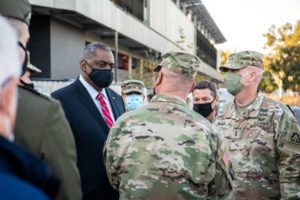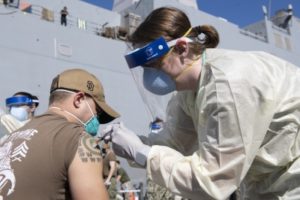
Secretary of Defense Lloyd J. Austin III visits with servicemembers assisting the Federal Emergency Management Agency COVID-19 vaccination site at California State University in Los Angeles in late February. He is urging all military personnel to be vaccinated. Air Force photo by Staff Sgt. Jack Sanders
WASHINGTON — The DoD cannot mandate immunization against COVID-19, but it can strongly encourage servicemembers to take a jab for the team. In recent weeks, military leadership has ramped up messaging and adopted some creative incentives to increase vaccine uptake.
Military command has been concerned that about one-third of military servicemembers, their families and civilian contractors are declining to be vaccinated for COVID-19. (See A Third of Military Healthcare Beneficiaries Refuse COVID-19 Vaccine).
In an effort to overcome vaccine hesitancy and counter misinformation, Secretary of Defense Lloyd J. Austin III posted a video on the Defense.gov website in late February urging everyone in the DoD’s workforce to go to the Centers for Disease Control and Prevention and the Defense Department’s websites to learn more about vaccine safety, effectiveness, and authorization process. “When you do, you’ll see that these vaccines have undergone intensive safety monitoring. You’ll see that they are safe and they are effective. And you’ll see that millions of your fellow citizens have already taken them with little to no side effects,” he said.
Austin kept the pitch soft, ending the video with “please think of yourselves and your teammates. And please do what you can to keep each other safe.”
The following day he bumped the message up a notch. At a large vaccination center in Los Angeles, he addressed the need to build trust in the vaccine, particularly in the African American community. “Because of some things that have happened in the past, there’s a degree of mistrust, and I think we have to collectively work hard to dispel rumors and to provide facts to people,” said Austin, who is the first African American defense secretary. “It’s been my experience that, when armed with the facts, people will tend to make the right decisions.”

Lt. Emily Goodwin, right, a doctor assigned to Navy Medicine Readiness and Training Unit Bahrain, administers the COVID-19 vaccine to Personnel Specialist 2nd Class Arnold McQuade, assigned to amphibious transport dock ship USS San Diego (LPD 22), in Manama, Bahrain. Navy photo by Mass Communication Specialist 2nd Class Brandon Woods)
Austin noted that information about the vaccines was being distributed through the chain of command, on the department’s website and through videos like his that have been made by a number of commanders. Several Army commands have posted videos from sergeants, medics and others discussing why they chose to receive the vaccine. Showing by example provides a level of confidence to others. Austin made the message explicit: “I’ve taken a vaccine. I consider it to be safe.”
He added that the DoD has seen few significant side effects from immunization and that the “efficacy is just incredible,” before closing with the clincher. “This saves lives. And it’s not just about saving our life, it’s about saving our partner’s life, our neighbor’s life. And in the military, we thrive on teamwork and we have to think about teammates, as well. So my getting the vaccine could potentially help save the life of a teammate.”
U.S. Army Forces Command (FORSCOM) posted several videos directly addressing the myths around the vaccine and encouraging soldiers to get their shots, even if they feel COVID-19 poses little risk to themselves. “If you get vaccinated, you’re doing it to protect someone else who might be at risk,” said Steven Cersovsky, MD, deputy director of the Army Public Health Center, during an Army town hall posted on FORSCOM’s Facebook page. “As long as you remain unvaccinated, you can become infected and pass it along to other people. You’re part of that transmission chain.”
“All Hands on Deck”
The vaccines offer the Navy a way out of an operational quagmire. The tight quarters make the spread of COVID-19 more likely and the isolation at sea makes separating infected sailors and receiving timely care for more-serious illness challenging at best. To minimize the risks, the service requires a 14-day restriction of movement (ROM)-sequester period for all personnel prior to deployment plus full health protection measures onboard.
Still, “nearly every ship in the Navy has had at least one case onboard,” wrote Vice Adm. Phillip Sawyer, deputy chief of Naval Operations, to Navy administration February 21 in an update to COVID-19 standardized operational guidance. Most were able to keep outbreaks from affecting more than 5% of their crews, but the aircraft carrier Theodore Roosevelt was unable to leave port for months as an outbreak that killed one sailor raged.
Those experiences gave the Navy great clarity on the advantages of vaccinating sailors. To stay on mission, “the key enablers are a highly immunized crew” and strict compliance with other steps shown to reduce spread of the virus, said Sawyer. The desire to immunize sailors as quickly as possible still needs to be balanced with the voluntary nature of the vaccine program at this point.
Consequently, the chief of naval operations, Adm. Mike Gilday, assured sailors that there would not be repercussions for declining the vaccine in a town hall in late January, while still encouraging everyone to step up. “Let me be clear here—while the COVID vaccine is voluntary, there will not be consequences for saying no at this time—to include the loss of leave or liberty. But, we urge each and every one of you to consider strongly getting this vaccine,” he said.
In keeping with Gilday’s promise, the February memo did not spell out any punishment for not getting the vaccine. It did, however, present a clear advantage for getting jabbed. “For immunized individuals, ROM-sequester is not required. A home to work schedule minimizing external contact should be employed,” allowing vaccinated sailors more time with their families. Nonimmunized individuals are still required to have a minimum 14-day ROM-sequester on the ship with test-in test-out prior to deployment.
In addition, crews that achieve 100% immunization do not require any ROM-sequester and may relax health protection measures after just one day for crews of fewer than 300 sailors, after four days for those with 300 to 999 sailors and after 14 days for the largest ships, as long as there is no contact with nonimmunized individuals.
Across the services, rates of immunization rise as deployment approaches. Even before Sawyer’s memo, 80% of the U.S.S. Eisenhower Carrier Strike Group planned to get at least their first shot prior to their Feb. 19 deployment. More than 90% of the sailors on the U.S.S. Iwo Jima and the marines in the 24th Marine Expeditionary Unit also received immunizations before deployment.
